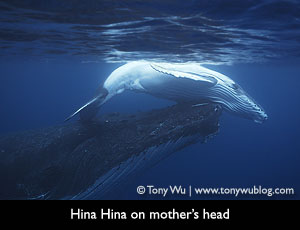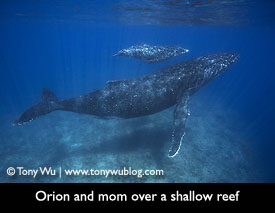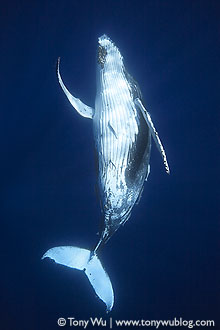 Another humpback whale season has come to a close...for me at least. The whales are still there, but I'm on my way back to face a mountain of work.
Another humpback whale season has come to a close...for me at least. The whales are still there, but I'm on my way back to face a mountain of work.
My final week in Tonga was hectic (as always). We had two excellent days with great weather and lots of whales...and then the winds came back, bringing harsh rain in the process. During those two days, we came upon two more calves, bringing the total to 14 for the season (#13 is Orion, named for a trio of marks reminiscent of Orion's belt, and #14 is named Hayato).
When I get the free time (ever the optimist), I hope to put together a photo summary of the calfs and moms, as well as the white-pec whales we spotted this year. The total number of white-pec whales came to four adults and one baby this year.
 A summary will come in useful next year, when we try to identify white-pec whales and see if any of the babies made it back. In practicality, it may be quite difficult to ID the babies as they mature, as they will have grown considerably larger by then, and many of the distinguishing marks may have become obscured (assuming the calfs return to the same islands or survive the long migrations).
A summary will come in useful next year, when we try to identify white-pec whales and see if any of the babies made it back. In practicality, it may be quite difficult to ID the babies as they mature, as they will have grown considerably larger by then, and many of the distinguishing marks may have become obscured (assuming the calfs return to the same islands or survive the long migrations).
Some summary observations for the season:
- The weather seemed "off" this year. The winds were constantly strong, and the normal cool, winter air was often replaced by unseasonably hot, heavy, humid air. Unexpectedly however, the best days were the few days with the hot air, when conditions were calm and whales were all over the place. It'll be interesting to see what the weather does in the next month or two...maybe the weather won't return to normal, or perhaps weather conditions are slightly time-shifted this year.
- I learned that most of the whale watch operators believe there are only a handful of calfs born in the Vava'u area each year, with estimates ranging from six to nine. We have photo/ video documentation of 14 this year, and that's fewer than we believe we have from previous years (though admittedly we weren't as methodical previously). I get the feeling that both locals and possibly researchers are significantly underestimating the local population and number of calfs. We'll see what happens next year.
- Calf births were late this year. Usually by end July/ early August, there are several calfs around. I have photos to prove this. This year, until we found Hina Hina in early August, no one credible had seen any babies. I use the term "credible" because it's very easy to be fooled by fleeting glimpses of whales at the surface, especially if you're desperately hoping to see a baby whale, so without photos or video...reports don't count. Last year, there was one calf spotted in December, which is really late. Perhaps this phenomenon is related to the odd weather, or perhaps not. There certainly seemed to be more calves appearing in the past couple of weeks, so it might be that the timing of births is "late" this year. Again, we'll see what happens next year.
- We found four all-white pec adult whales and one baby whale this season. Given that these whales are much easier to identify than normally pigmented whales, it'll be very interesting to see whether they show up again. I have to find time to assemble a photographic summary of the white-pec whales from last year and this year, so I have a handy reference tool next season.
 As I make my way back to the big city, I keep reminding myself of how lucky I am. How many people have a chance to spend a month or more each year studying humpback whales, swimming with them and learning about their behaviour through direct observation?
As I make my way back to the big city, I keep reminding myself of how lucky I am. How many people have a chance to spend a month or more each year studying humpback whales, swimming with them and learning about their behaviour through direct observation?
As I understand more each year, and as I reflect on the experiences when I get back to "normal" life, more and more questions arise.
...which reminds me, I've been sent a list of questions to answer for a newspaper interview in Singapore, and the overall gist of many of the questions is asking how I stay motivated.
When you see and experience amazing things like I'm fortunate enough to do, there's no need to stay motivated. The more I think, study and learn about humpbacks all year long, the more I'll enjoy my time with them, and the better my chances of figuring out what they're doing. That's all the motivation I need.
I'll continue to upload photos to Flickr as and when I can...